时效硬化
可时效硬化的高温合金

c 中电 阻丝合 金 中添加 了 T 和 A 。这 种合 金 就 r i l 是开 发于 14 90~14 94年 问 、 今仍 在 使 用 的 8 A 至 0 镍基 高温 合金 的前 身 。 直 到 13 95~14 年 第 二 次 世界 大 战期 间激 9 起 了对适 用 于早 期飞 行器 燃气 发动 机 的改 进型合
化物 扩散 强化 的高温 合金 这些 也能 使性 能得 到增
强 的材料 进行 讨论 。 高 温合 金 的用途 最早 的可 时效硬 化 的高温 合 金可追 溯 到大 约 12 9 9年 , 当时 , 多开 发者 在 标准 的 8 %N / 0 许 0 i2 %
些合 金 甚至 可 以含有 多达 1 故 意添 加 的元 素 , 2种 以有助 于在 高温 下 赋予并 保 持材料 的关键 性 能 。 在 高 温合 金 中必 须 严 格 控 制 许 多 其 它 的元
维普资讯
上
海
钢
研
20 0 6年第 2期
可 时效硬 化 的 高温合金
为了 对某一 特 定 的用途 选择 最合 适 的锻轧 可 时效硬 化 的高 温合 金 , 程 师 们必 须 了解 基 本 的 工 力学性 能 以及 其他 特性 , 如抗 疲 劳 、 裂纹 扩展 诸 抗
ห้องสมุดไป่ตู้
的允许 量也 不 高 , 且 通 常具 有 较 低 的力 学 性 能 而
高温 合金 的基 本用 途仍 旧是 飞行 器 的燃气 轮 发 动机 的高 温部 分 , 要 占先 进 的发 动机 重 量 的 它
Fe-1.55Cu合金的时效硬化

第2 8卷第 2 期
20 0 7年 4月
热处理技术与装 备
RE HUL IHU HU C IJS YU Z ANGB I E
Vo . 8. . 1 2 No 2 Ap ,0 7 r2 0
时效 硬 化 e1 5 C
we e f lr e n mb r fC - c l se sd s b td i ef r t ma r ,t e s eo h c sa o t 0 — r g u es o u r h cu tr it u e t er e l a i i r nh i t x h i f ih wa b u i z w 2 7 l .W i h o d n i ,t e r h c p e a t l s w r o s n d n d t u e o mir h r n s 2 nn h t t eh lig t me h c - o p r p r ce e e c a e e ,a s ld t c o a d e s i i r h
低 ;5 = 时效阶段 , 50c过 I 铁素体晶粒中分布着大量的铜原子富集 区, 颗粒尺寸约 2 — 2 m, 0 7 随着等温 n
时效 时 间的延 长 , 富铜 析 出物不 断粗化 长 大 , 而导致硬度 下 降。 从 关键 词 : 含铜 高纯钢 ; 固溶 ; 时效硬 化 ; 出 析
中 图分类 号 : T 4 .1T 15 文献标 识码 : B 文章 编号 :63— 9 120 )2— 0 9— 4 G124 ,G 1 17 4 7 (0 7 0 02 0
Ag i g Be a i u fFe 1 5 o en h vo r o - . 5 Cu AH y
so e n ea n ek hrn s w sl e.A vraigpoeso 5 I gn et et hee h r r dt g gp a ad es a w r t e-g rcs f 0 c igt a n .t r t a h i o o n 5 =a r m
混凝土的时效硬化
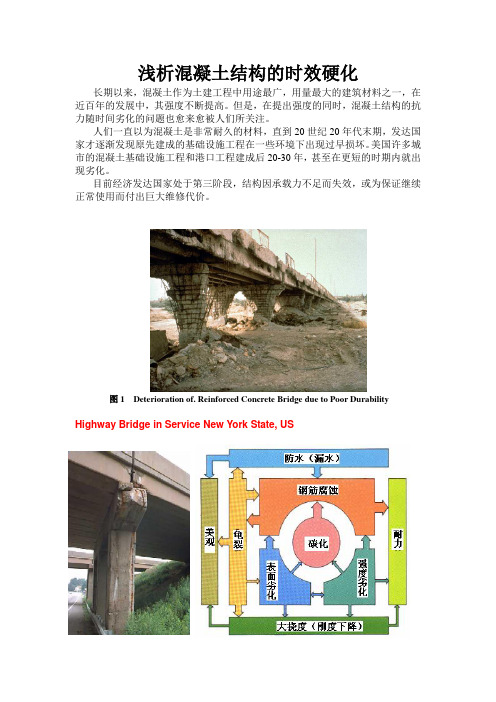
浅析混凝土结构的时效硬化长期以来,混凝土作为土建工程中用途最广,用量最大的建筑材料之一,在近百年的发展中,其强度不断提高。
但是,在提出强度的同时,混凝土结构的抗力随时间劣化的问题也愈来愈被人们所关注。
人们一直以为混凝土是非常耐久的材料,直到20世纪20年代末期,发达国家才逐渐发现原先建成的基础设施工程在一些环境下出现过早损坏。
美国许多城市的混凝土基础设施工程和港口工程建成后20-30年,甚至在更短的时期内就出现劣化。
目前经济发达国家处于第三阶段,结构因承载力不足而失效,或为保证继续正常使用而付出巨大维修代价。
图1 Deterioration of. Reinforced Concrete Bridge due to Poor DurabilityHighway Bridge in Service New York State, US我国建设部的一项调查表明,国内大多数工业建筑物在使用25-30年后即需大修,处于严酷环境下的建筑物使用寿命仅15-20年。
民用建筑和公共建筑的使用环境相对较好,一般可维持50年以上,但室外的阳台、雨罩等露天构件的使用寿命通常仅有30-40年。
桥梁、港口等基础设施工程的耐久性问题更为严重,由于钢筋的混凝土保护层过薄且密实性差,许多工程建成后几年就出现钢筋锈蚀、混凝土开裂。
海港码头一般使用10年左右就因混凝土顺筋开裂和剥落,需要大修。
当前,我国的基础设施建设工程规模宏大,投入资金每年高达2万亿元人民币以上,约30-50年后,这些工程将进入维修期,所需的维修费用将更为巨大。
有专家估计,我国“大干”基础设施工程建设的高潮还可延续20年,由于忽视耐久性问题,迎接我们的还会有“大修”20年的高潮,这个高潮可能不用很久就将到来,其耗费将当初这些工程施工建设时的投资。
因此,研究混凝土结构的时效硬化,改善混凝土结构的抗力劣化,延长工程的使用寿命。
尽量减少维修重建的费用是建筑行业实施可持续发展战略的关键。
铝合金的时效强化是如何进行和完成的

铝合金的时效强化是如何进行和完成的经淬火后的铝合金强度、硬度随时间延长而发生显著提高的现象称之为时效,也称铝合金的时效硬化。
这是铝合金强化的重要方法之一。
由定义可知,铝合金时效强化的前提,首先是进行淬火,获得饱和单相组织。
在快冷淬火获得的固溶体,不仅溶质原子是过饱和的,而且空位(晶体点缺陷)也是过饱和的,即处于双重过饱和状态。
以Al -4%Cu 合金为例,固溶处理后,过饱和α固溶体的化学成分就是合金的化学成分,即固溶体中钢含量为4%。
由Al-Cu 相图可知,在室温平衡态下,α固溶体的含铜量仅为0.5%,故3.5%Cu过饱和固溶于α相中。
当温度接近纯铝熔点时,空位浓度接近10-3数量级,而在常温下,空位浓度为10-11数量级,二者相差10-8级。
经研究可知;铝合金固溶处理温度越高,处理后过饱和程度也越大,经时效后产生的时效强化效果也越大。
因此固溶处理温度选择原则是:在保证合金不过烧的前提下,固溶处理温度尽可能提高。
固溶处理后的铝铜合金,在室温或某一温度下放置时,发生时效过程。
此过程实质上是第二相Al2Cu 从过饱和固溶体中沉淀的过程。
这种过程是通过成型和长大进行的,是一种扩散型的固态相变。
它依下列顺序进行:a过→G.P区→θ’’相→θ’相→θ相G.P区就是指富溶质原子区,对Al-Cu合金而言,就是富铜区。
铝钢合金的G.P区是铜原子在(100)晶面上偏聚或从聚而成的,呈圆片状。
它没有完整的晶体结构,与母相共格。
200℃不再生成G.P 区。
室温时效的G.P区很小,直径约50A,密度为1014-1015/mm3,G.P区之间的距离为20-40 ?。
130℃时效15h后,G.P 区直径长大到90 ?,厚为4-6 ?。
温度再高,G.P区数目开始减少。
它可以在晶面处引起弹性应变。
θ’’相是随时效温度升高或时效时间延长,G.P区直径急剧长大,且铜、铝原子逐渐形成规则排列,即正方有序结构。
在θ’’过渡相附近造成的弹性共格应力场或点阵畸变区都大于G.P区产生的应力场,所以θ’’相产生的时效强化效果大于G.P区的强化作用。
盐浴热处理原理
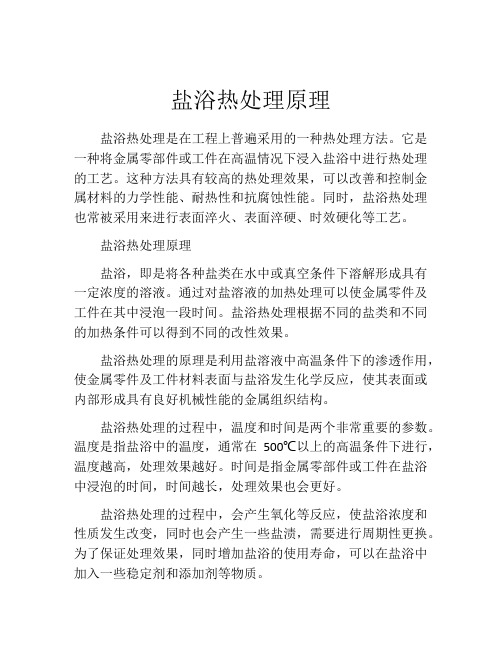
盐浴热处理原理盐浴热处理是在工程上普遍采用的一种热处理方法。
它是一种将金属零部件或工件在高温情况下浸入盐浴中进行热处理的工艺。
这种方法具有较高的热处理效果,可以改善和控制金属材料的力学性能、耐热性和抗腐蚀性能。
同时,盐浴热处理也常被采用来进行表面淬火、表面淬硬、时效硬化等工艺。
盐浴热处理原理盐浴,即是将各种盐类在水中或真空条件下溶解形成具有一定浓度的溶液。
通过对盐溶液的加热处理可以使金属零件及工件在其中浸泡一段时间。
盐浴热处理根据不同的盐类和不同的加热条件可以得到不同的改性效果。
盐浴热处理的原理是利用盐溶液中高温条件下的渗透作用,使金属零件及工件材料表面与盐浴发生化学反应,使其表面或内部形成具有良好机械性能的金属组织结构。
盐浴热处理的过程中,温度和时间是两个非常重要的参数。
温度是指盐浴中的温度,通常在500℃以上的高温条件下进行,温度越高,处理效果越好。
时间是指金属零部件或工件在盐浴中浸泡的时间,时间越长,处理效果也会更好。
盐浴热处理的过程中,会产生氧化等反应,使盐浴浓度和性质发生改变,同时也会产生一些盐渍,需要进行周期性更换。
为了保证处理效果,同时增加盐浴的使用寿命,可以在盐浴中加入一些稳定剂和添加剂等物质。
盐浴热处理的应用盐浴热处理的应用非常广泛,主要涉及到钢、铝合金、铜合金等金属材料的处理。
常见的盐类包括氯化钠、氯化钾、氯化钙、氯化镁等,选择不同的盐类和盐浴加热条件可以得到不同的改性效果。
1.表面淬火表面淬火是将金属零件或工件的表面在高温条件下浸入盐浴中进行,然后立即从盐浴中取出冷却,可以获得较硬、较脆的表面层,提高零件和工件的耐磨性、耐腐蚀性和耐热性。
2.表面淬硬表面淬硬是将金属零件或工件表面在加热至一定温度的盐浴中浸泡一定的时间,然后取出并迅速冷却,使金属表面形成一层较硬、较韧的组织结构,从而提高零件和工件的使用寿命。
3.时效硬化时效硬化是将金属零件或工件在高温下浸泡一定时间,然后迅速冷却并在室温下储存,使其形成改善的组织结构。
18Ni(300)时效硬化型塑料模具钢

时效硬化型塑料模具钢(F141)模具热处理后变形是模具热处理的三大难题之一(变形、开裂、淬硬)。
预硬型塑料模具钢解决了模具热处理变形问题,但模具要求硬度高又给模具加工造成困难。
熔化既保持模具的加工精度,又使模具具有较高硬度,对于复杂、精密、长寿命的塑料模具,是模具材料面临的一个重要难题。
为此发展了一系列的时效硬化型塑料模具钢。
模具零件在淬火(固溶)后变软(硬度约为28~34HRC),便于切削加工成形,然后再进行时效硬化,获得所需的综合力学性能。
时效硬化型塑料模具钢有马氏体时效硬化钢和析出(沉淀)硬化钢两大类。
马氏体时效钢有高的屈强比、良好的切削加工性和焊接性能,热处理工艺简单等优点。
典型的高合金马氏体时效硬化钢有18Ni(200)(00Ni18Co8Mo3TiAl)钢、18Ni(250)(00Ni18Co8MoTiAl)钢、18Ni(300)(00Ni18Co9Mo5TiAl)钢、19Ni(350)(00Ni18Co13Mo4TiAl)钢等,固溶以后形成超低碳马氏体,硬度约为30~32HRC;时效处理以后,由于各种类型的金属间化合物的脱、析出,得到时效硬化,硬度可上升到50HRC以上。
这类钢在高强度、高韧性的条件下仍具有良好的塑性、韧性和高的断裂韧度。
为了降低材料费用,近年来开发了一类低钴、无钴、低镍的马氏体时效钢,其代表钢种如06Ni(06Ni6CrMoVTiAl)钢、AFC-77(1Cr14Co13Mo5V)钢;另一类为低合金时效硬化钢,代表钢号如我国自行开发的25CrNi3MoAl钢,PMS(1Ni3MnMoCuAl)钢、PCR(0Cr16Ni4Cu3Nb)钢、SM2(20CrNi3AlMnMo)钢等,另外还有美国的P2(20CrNi4AlV)钢,日本大同特殊钢公司的NAK80、NAK55(15Ni3MnMoAlCuS)钢等,这类钢经固溶处理后,硬度为30HRC左右,时效处理后,由于金属间化合Ni3Al析出而强化,硬度可以上升到38~42HRC。
Rene 41时效硬化镍基合金—上海勃西曼特殊钢提供

对应牌号:W.NR 2.4973,UNS N07041,AWS 120
适用标准:AMS 5545 AMS 5800
Rene 41是一种时效硬化镍基合金,在高温下具有非常高的强度,特别是在650 - 980oC (1200 - 1800oF)范围内。通过选择冷加工及/或热处理工序,可以特制所需的机械性能。Rene 41还具有良好的抗氧化性能。
高温条件下机械特性优良
是
环境温度下耐腐蚀
否
高温条件下耐腐蚀和机械性能优良
否
耐氧化
是
沉淀物可硬化
是
应用领域包括:
后燃烧器部件
涡轮机铸件
螺栓
其他紧固件
近似化学成分
Cr
18 - 20%
Co
12%
Mo
9 - 10.5%
Ti
3.0 - 3.3%
Al
1.4 - 1.6%
Ni
BAL
物理性能
密度
8.25 g/cm3
116 - 159ksi
退火+老化
1350 - 1550 N/mm2
196 - 225ksi
最高+550ºC
最高+1020ºF
弹簧回火
1400 - 1800 N/mm2
203 - 261ksi
弹簧回火+退火+老化
1350 - 1550 N/mm2
196 - 225ksi
最ห้องสมุดไป่ตู้+550ºC
最高+1020ºF
0.298 lb/in3
熔点
1345oC
2450oF
膨胀系数
13.6 µm/m °C
(20 - 100°C)
时效硬化型塑料模具钢
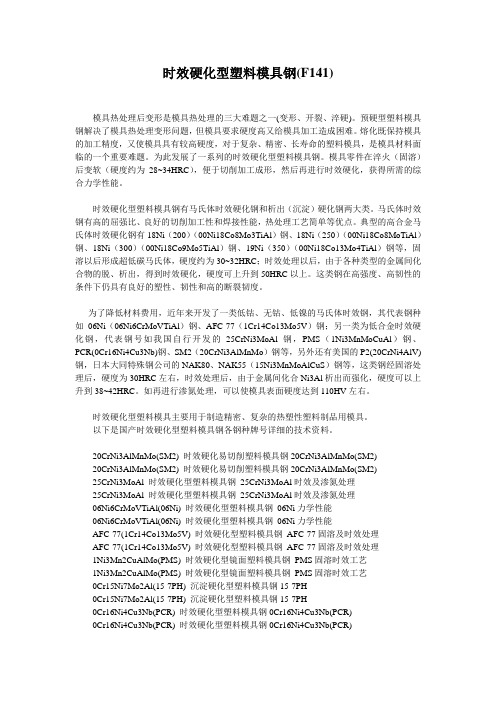
时效硬化型塑料模具钢(F141)模具热处理后变形是模具热处理的三大难题之一(变形、开裂、淬硬)。
预硬型塑料模具钢解决了模具热处理变形问题,但模具要求硬度高又给模具加工造成困难。
熔化既保持模具的加工精度,又使模具具有较高硬度,对于复杂、精密、长寿命的塑料模具,是模具材料面临的一个重要难题。
为此发展了一系列的时效硬化型塑料模具钢。
模具零件在淬火(固溶)后变软(硬度约为28~34HRC),便于切削加工成形,然后再进行时效硬化,获得所需的综合力学性能。
时效硬化型塑料模具钢有马氏体时效硬化钢和析出(沉淀)硬化钢两大类。
马氏体时效钢有高的屈强比、良好的切削加工性和焊接性能,热处理工艺简单等优点。
典型的高合金马氏体时效硬化钢有18Ni(200)(00Ni18Co8Mo3TiAl)钢、18Ni(250)(00Ni18Co8MoTiAl)钢、18Ni(300)(00Ni18Co9Mo5TiAl)钢、19Ni(350)(00Ni18Co13Mo4TiAl)钢等,固溶以后形成超低碳马氏体,硬度约为30~32HRC;时效处理以后,由于各种类型的金属间化合物的脱、析出,得到时效硬化,硬度可上升到50HRC以上。
这类钢在高强度、高韧性的条件下仍具有良好的塑性、韧性和高的断裂韧度。
为了降低材料费用,近年来开发了一类低钴、无钴、低镍的马氏体时效钢,其代表钢种如06Ni(06Ni6CrMoVTiAl)钢、AFC-77(1Cr14Co13Mo5V)钢;另一类为低合金时效硬化钢,代表钢号如我国自行开发的25CrNi3MoAl钢,PMS(1Ni3MnMoCuAl)钢、PCR(0Cr16Ni4Cu3Nb)钢、SM2(20CrNi3AlMnMo)钢等,另外还有美国的P2(20CrNi4AlV)钢,日本大同特殊钢公司的NAK80、NAK55(15Ni3MnMoAlCuS)钢等,这类钢经固溶处理后,硬度为30HRC左右,时效处理后,由于金属间化合Ni3Al析出而强化,硬度可以上升到38~42HRC。
2016新编铝合金的时效强化是如何进行和完成的

铝合金的时效强化是如何进行和完成的经淬火后的铝合金强度、硬度随时间延长而发生显著提高的现象称之为时效,也称铝合金的时效硬化。
这是铝合金强化的重要方法之一。
由定义可知,铝合金时效强化的前提,首先是进行淬火,获得饱和单相组织。
在快冷淬火获得的固溶体,不仅溶质原子是过饱和的,而且空位(晶体点缺陷)也是过饱和的,即处于双重过饱和状态。
以Al -4%Cu合金为例,固溶处理后,过饱和α固溶体的化学成分就是合金的化学成分,即固溶体中钢含量为4%。
由Al-Cu 相图可知,在室温平衡态下,α固溶体的含铜量仅为0.5%,故3.5%Cu过饱和固溶于α相中。
当温度接近纯铝熔点时,空位浓度接近10-3数量级,而在常温下,空位浓度为10-11数量级,二者相差10-8级。
经研究可知;铝合金固溶处理温度越高,处理后过饱和程度也越大,经时效后产生的时效强化效果也越大。
因此固溶处理温度选择原则是:在保证合金不过烧的前提下,固溶处理温度尽可能提高。
固溶处理后的铝铜合金,在室温或某一温度下放置时,发生时效过程。
此过程实质上是第二相Al2Cu从过饱和固溶体中沉淀的过程。
这种过程是通过成型和长大进行的,是一种扩散型的固态相变。
它依下列顺序进行:a过→G.P区→θ’’相→θ’相→θ相G.P区就是指富溶质原子区,对Al-Cu合金而言,就是富铜区。
铝钢合金的G.P区是铜原子在(100)晶面上偏聚或从聚而成的,呈圆片状。
它没有完整的晶体结构,与母相共格。
200℃不再生成G.P 区。
室温时效的G.P区很小,直径约50A,密度为1014-1015/mm3,G.P 区之间的距离为20-40 ?。
130℃时效15h后,G.P 区直径长大到90 ?,厚为4-6 ?。
温度再高,G.P区数目开始减少。
它可以在晶面处引起弹性应变。
θ’’相是随时效温度升高或时效时间延长,G.P区直径急剧长大,且铜、铝原子逐渐形成规则排列,即正方有序结构。
在θ’’过渡相附近造成的弹性共格应力场或点阵畸变区都大于G.P 区产生的应力场,所以θ’’相产生的时效强化效果大于G.P区的强化作用。
钢结构时效硬化名词解释

钢结构时效硬化名词解释1.引言1.1 概述概述是一篇文章的开篇部分,旨在为读者简要介绍文章的主题和内容。
钢结构时效硬化是指通过控制钢材的加热和冷却过程,使其在室温下逐渐达到一种理想的物理和力学性能。
时效硬化的过程中,钢材内部的晶体结构会发生变化,使其硬度和强度得到提高,从而使钢结构更加耐久和稳定。
本文将详细介绍钢结构时效硬化的原理、方法和应用,并探讨其对于钢结构工程的意义和影响。
通过阅读本文,读者将能够全面了解钢结构时效硬化的概念和技术,并为相关领域的实践提供理论依据和参考指导。
1.2 文章结构文章结构部分的内容应包括以下内容:文章的结构是为了使读者更好地理解和掌握钢结构时效硬化的概念和意义。
文章的结构主要分为三个部分:引言、正文和结论。
在引言部分,首先需要概述本文的主题和目的,简要介绍钢结构和时效硬化的背景,让读者对文章的内容有一个整体的了解。
然后,需要详细说明文章的结构,即文章的各个部分将分别介绍什么内容,引导读者进一步阅读。
在正文部分,首先介绍钢结构的相关知识,包括钢结构的定义、特点和应用领域,为后续对时效硬化的解释提供必要的背景知识。
然后,详细解释时效硬化的概念和原理,可以包括时效硬化的定义、时效硬化对钢结构力学性能的影响,以及时效硬化的材料组织变化等内容。
在解释时效硬化时,可以引用相关的理论和实验研究结果,加强文章的可信度和科学性。
在结论部分,首先对整篇文章进行总结,重点强调钢结构时效硬化的重要性和实际应用价值。
然后,对钢结构时效硬化的意义进行深入探讨,可以从经济、安全、可持续发展等角度进行分析,阐述钢结构时效硬化的优势和前景。
通过以上三个部分的逐步展开,读者可以全面了解钢结构时效硬化的相关知识和意义,对文章的内容有一个清晰的认识。
同时,文章结构的合理性和逻辑性也可以提高读者阅读的效果和体验。
1.3 目的本文的目的是对钢结构时效硬化这一概念进行全面而深入的解释和阐述。
钢结构作为一种重要的工程材料,在现代建筑领域得到广泛应用。
时效硬化的名词解释
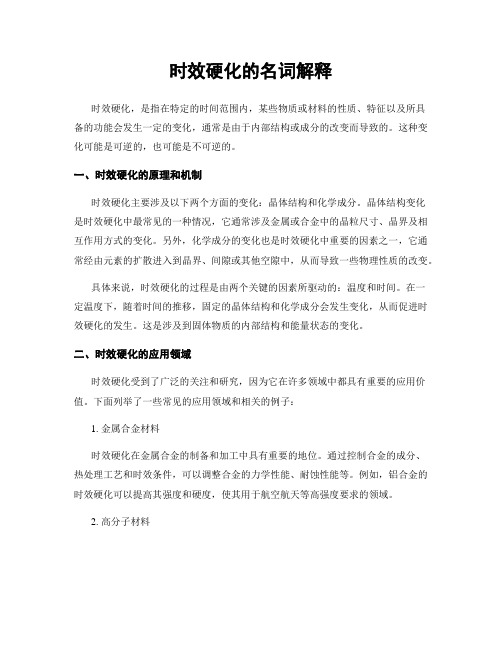
时效硬化的名词解释时效硬化,是指在特定的时间范围内,某些物质或材料的性质、特征以及所具备的功能会发生一定的变化,通常是由于内部结构或成分的改变而导致的。
这种变化可能是可逆的,也可能是不可逆的。
一、时效硬化的原理和机制时效硬化主要涉及以下两个方面的变化:晶体结构和化学成分。
晶体结构变化是时效硬化中最常见的一种情况,它通常涉及金属或合金中的晶粒尺寸、晶界及相互作用方式的变化。
另外,化学成分的变化也是时效硬化中重要的因素之一,它通常经由元素的扩散进入到晶界、间隙或其他空隙中,从而导致一些物理性质的改变。
具体来说,时效硬化的过程是由两个关键的因素所驱动的:温度和时间。
在一定温度下,随着时间的推移,固定的晶体结构和化学成分会发生变化,从而促进时效硬化的发生。
这是涉及到固体物质的内部结构和能量状态的变化。
二、时效硬化的应用领域时效硬化受到了广泛的关注和研究,因为它在许多领域中都具有重要的应用价值。
下面列举了一些常见的应用领域和相关的例子:1. 金属合金材料时效硬化在金属合金的制备和加工中具有重要的地位。
通过控制合金的成分、热处理工艺和时效条件,可以调整合金的力学性能、耐蚀性能等。
例如,铝合金的时效硬化可以提高其强度和硬度,使其用于航空航天等高强度要求的领域。
2. 高分子材料时效硬化在高分子材料中也有广泛的应用。
例如,热固性树脂在加热条件下发生交联反应,使其硬化成为不可溶性和耐高温的固体。
这种硬化过程可以改变高分子材料的力学性能、耐热性能以及耐化学腐蚀性能。
3. 混凝土材料时效硬化在混凝土制品中也起着重要的作用。
例如,利用适当的水灰比和混凝土配方,经过一定时间的养护,可以使混凝土达到预期的力学性能。
这种时效硬化有助于提高混凝土的强度、耐久性和抗渗性。
4. 医疗器械在医疗器械的制造中,时效硬化可以用来改变材料的性质和形状,从而实现特定的医疗功能。
例如,通过调整医用塑料材料的时效硬化条件,可以改变其刚度和变形性能,使其在手术中具有更好的适应性和可操作性。
铝合金时效硬化特性与应力腐蚀性能研究01-10
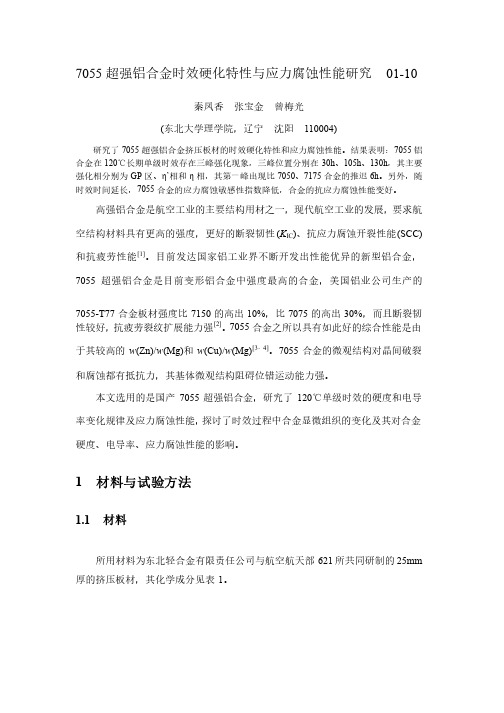
7055超强铝合金时效硬化特性与应力腐蚀性能研究超强铝合金时效硬化特性与应力腐蚀性能研究 01-10 秦凤香秦凤香 张宝金张宝金 曾梅光曾梅光(东北大学理学院,辽宁东北大学理学院,辽宁 沈阳沈阳 110004) 研究了7055超强铝合金挤压板材的时效硬化特性和应力腐蚀性能。
结果表明:7055铝合金在120℃长期单级时效存在三峰强化现象,三峰位置分别在30h 、105h 、130h ,其主要强化相分别为GP 区、η’相和η相,其第一峰出现比7050、7175合金的推迟6h 。
另外,随时效时间延长,7055合金的应力腐蚀敏感性指数降低,合金的抗应力腐蚀性能变好。
合金的应力腐蚀敏感性指数降低,合金的抗应力腐蚀性能变好。
高强铝合金是航空工业的主要结构用材之一,高强铝合金是航空工业的主要结构用材之一,现代航空工业的发展,现代航空工业的发展,要求航空结构材料具有更高的强度,更好的断裂韧性(K IC )、抗应力腐蚀开裂性能(SCC)和抗疲劳性能[1]。
目前发达国家铝工业界不断开发出性能优异的新型铝合金,7055超强铝合金是目前变形铝合金中强度最高的合金,美国铝业公司生产的7055-T77合金板材强度比7150的高出10%,比7075的高出30%,而且断裂韧性较好,抗疲劳裂纹扩展能力强[2]。
7055合金之所以具有如此好的综合性能是由于其较高的w (Zn)/w (Mg)和w (Cu)/w (Mg)[3,4]。
7055合金的微观结构对晶间破裂和腐蚀都有抵抗力,其基体微观结构阻碍位错运动能力强。
本文选用的是国产7055超强铝合金,研究了120℃单级时效的硬度和电导率变化规律及应力腐蚀性能,探讨了时效过程中合金显微组织的变化及其对合金硬度、电导率、应力腐蚀性能的影响。
1 材料与试验方法1.1 材料所用材料为东北轻合金有限责任公司与航空航天部621所共同研制的25mm 厚的挤压板材,其化学成分见表1。
表1 实验用料7055合金各元素质量分数合金各元素质量分数/% /%━━━━━━━━━━━━━━━━━━━━━━━━━━━━━━━━━ Zn Mg Cu Mn Cr Fe Si Zr Ti Al ─────────────────────────────────7.77 1.82 2.12 <0.05 <0.04 0.13 0.078 0.13 0.16 余量余量 ━━━━━━━━━━━━━━━━━━━━━━━━━━━━━━━━━1.2 热处理Φ192mm 的铸锭在430℃挤压成25mm 厚的板材。
机械材料铝合金之时效硬化

S10C
S15C
S20C
S30C
S40C
S50C
火花試驗訣竅
•碳鋼務必練習0.1、0.5兩支試棒 • 作答以0.15、0.35、0.45為主 • 例如0.35作答時,則0.30~0.40均為滿分 • 作答時要寫成0.30。如寫成0.3時為零分 •請勿開日光燈,可減少誤判 (如現場有開日光燈時提醒評審關掉,可留
指定項目:乙級必考(依考生選考一項) ◎露點測定 ◎高周波硬化 ◎鹽浴處理
丙級術科分 5 站實施,各站項目及限定時間:
◆ (一) 火花試驗
5分鐘
(一般碳鋼)二支
(二) 洛氏(Rockwell)硬度試驗
10分鐘
(手動式)HRB、HRC 試片每人各一片
(三) 金相組織辨識
5分鐘
(碳鋼、熱處理 、表面硬化、鑄鐵)
High Speed
SKH 2
鎢系高速鋼, (18%W+0.78%C+1.0%V)
High Speed
SKH 51
鉬系高速鋼, (5%Mo+6.1%W+0.85%C+1.9%V)
Die→模具
SKD11
冷作模具鋼, (12%Cr+1.5%C+1.0%Mo+0.35%V)
Die→模具
SKD61
評審位置的燈光)
ห้องสมุดไป่ตู้
0.15
(S20C)
0.35
(S40C)
10
10 100
40
20
40
一、試題名稱:火花試驗(乙級)
(一) 試題說明:藉火花試驗判定碳鋼之含碳量及合金鋼種。 (三) 評分標準:監評隨機取碳鋼及合金鋼各一支。
混凝土的时效硬化

式中: β------结构构件的可靠指标 -------结构构件作用效应的平均值和标准差 ------结构构件抗力的平均值和标准差
上述式子的缺点是:
在分析中忽略了基本变量随时间变化的关系,即忽视了 基本变量的时变性,从而导致现行结构可靠度的评定方法是 一种近似概率方法,据此求得的结构可靠度也是静态可靠度。 单就钢筋混凝土结构而言,在使用早期,可靠度一般比 设计值有所提高,这是因为在此期间混凝土强度有较大幅度 的提高,但钢筋混凝土存在耐久性问题,即其性能会随时间 发生退化,使结构的强度、刚度、可靠度降低。同时,由于 结构刚度的变化对结构的动力性能产生直接的影响,从而使 结构的动力荷载效应发生变化,并二次影响到结构可靠度。
影响混凝土碳化的因素
①材料因素 ◆ 水泥。其品种和用量决定了单位体积中可碳化物质 (CaO)的含量,因而对混凝土碳化有重要影响。单位体 积中水泥的用量越多,会提高混凝土的强度,又会提高混 凝土的抗碳化性能。 ◆ 水灰比。在水泥用量不变的条件下,水灰比越大, 混凝土孔隙中游离水越多,蒸发后混凝土内部的孔隙率也 越大,密实性就越差,CO2的渗入速度越快,因而碳化的 速度也越快。 ◆ 混凝土中外加掺合料和骨料品种 ②施工养护质量的影响 混凝土搅拌、振捣和养护条件影响混凝土的密实性, 因而对碳化有较大影响。此外,养护方法与龄期对水泥的 水化程度有影响,也会影响混凝土的碳化。
ห้องสมุดไป่ตู้
3.2 碱-集料反应及其影响机制
混凝土集料中的某些活性矿物质与混凝土中所含的碱性溶 液(Na2O+K2O)产生化学反应称为碱-集料反应。碱-集料反 应导致混凝土破坏特征均表现为混凝土膨胀开裂,大量微裂缝 的产生不仅降低混凝土的力学性能,更重要的是加速了水、腐 蚀离子渗入混凝土内部,从而诱发碱骨料反应、钢筋锈蚀、冻 融破坏协调效应,严重影响了混凝土工程耐久性。再有碱-集 料反应是在混凝土碱活性骨料周围缓慢、长期发生的,不仅无 法阻止其破坏继续发展,且破坏后不宜修复,因此被称为混凝 土的“癌症”。
时效硬化名词解释
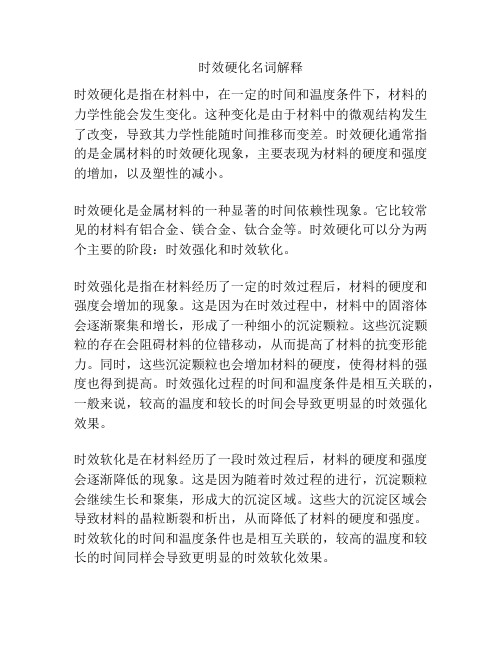
时效硬化名词解释
时效硬化是指在材料中,在一定的时间和温度条件下,材料的力学性能会发生变化。
这种变化是由于材料中的微观结构发生了改变,导致其力学性能随时间推移而变差。
时效硬化通常指的是金属材料的时效硬化现象,主要表现为材料的硬度和强度的增加,以及塑性的减小。
时效硬化是金属材料的一种显著的时间依赖性现象。
它比较常见的材料有铝合金、镁合金、钛合金等。
时效硬化可以分为两个主要的阶段:时效强化和时效软化。
时效强化是指在材料经历了一定的时效过程后,材料的硬度和强度会增加的现象。
这是因为在时效过程中,材料中的固溶体会逐渐聚集和增长,形成了一种细小的沉淀颗粒。
这些沉淀颗粒的存在会阻碍材料的位错移动,从而提高了材料的抗变形能力。
同时,这些沉淀颗粒也会增加材料的硬度,使得材料的强度也得到提高。
时效强化过程的时间和温度条件是相互关联的,一般来说,较高的温度和较长的时间会导致更明显的时效强化效果。
时效软化是在材料经历了一段时效过程后,材料的硬度和强度会逐渐降低的现象。
这是因为随着时效过程的进行,沉淀颗粒会继续生长和聚集,形成大的沉淀区域。
这些大的沉淀区域会导致材料的晶粒断裂和析出,从而降低了材料的硬度和强度。
时效软化的时间和温度条件也是相互关联的,较高的温度和较长的时间同样会导致更明显的时效软化效果。
时效硬化对于金属材料的应用具有重要的意义。
通过控制时效硬化过程,可以使得金属材料的力学性能得到提高,从而满足不同的工程需求。
同时,时效硬化也可以通过改变时效温度和时间的控制,来精确调节材料的力学性能,实现材料的精准加工和使用。
铝合金时效硬化曲线的测定 ppt课件
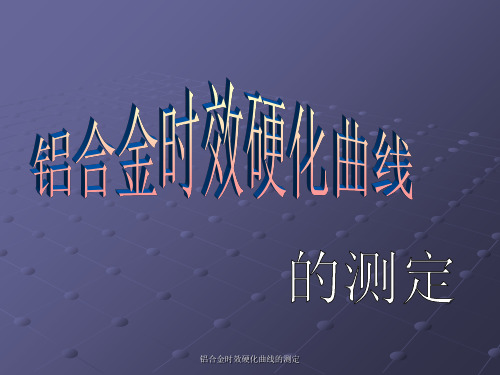
铝合金时效硬化曲线的测定
一、实验目的
掌握固溶淬火及时效处理的基本操作。 了解时效温度和时效时间对时效强化效 果的影响规律。 加深对时效强化及其机制的理解。
铝合金时效硬化曲线的测定
二、实验原理概述
定义:从过饱和固溶体中析出第二相(沉
淀相)或形成溶质原子聚集区以及亚稳定 过渡相的过程称为脱溶或沉淀,是一种扩 散型相变。
其中 相为平衡相,可以是端际固溶体,也可以是中间相,反应产物 为 ( ) 双相组织。将这种双相组织加热到固溶度线以上某一温度
(如T1)保温足够时间,将获得均匀的单相固溶体相,这种处理称为固 溶处理。
铝合金时效硬化曲线的测定
图1 固溶 处理 与时 效处 理的 工艺 过程 示意 图
二、实验原理概述
温时效的温度越高,硬度上升就越快,达到最大值的 时间就越短,但所能达到的最大硬度值反而就越低。
铝合金时效硬化曲线的测定
二、实验原理概述
图2 冷时效和铝合温金时时效效硬化过曲线程的硬测定度变化示意图
二、实验原理概述
图3 Al-Cu合金在130℃时效时的硬度和析出相的关系 铝合金时效硬化曲线的测定
二、实验原理概述
铝合金时效硬化曲线的测定
四、实验步骤与方法
每班分成五个小组,每组分别领取一套样品 (12块),作好标记。 将试样用砂纸或预磨机磨掉车痕,以达平整、 光洁,然后用铁丝绑好。 将绑好试样在盐浴槽中加热。加热温度为 500±3℃,保温约10~15分钟,保温结束后 快速淬入水槽中。 每组取一个试样立即测定淬火后的硬度。
时效硬(强)化或沉淀硬(强)化:若将经过固溶处
理后的C0成分合金急冷,抑止 相 分解,则在室温下获得 亚稳的过饱和 相 固溶体。这种过饱和固溶体在室温或 较高温度下等温保持时,亦将发生脱溶,但脱溶相往往不 是状态图中的平衡相,而是亚稳相或溶质原子聚集区。这 种脱溶可显著提高合金的强度和硬度,称为时效硬(强)化 或沉淀硬(强)化。
析出强化锡青铜时效硬化探究

析出强化锡青铜时效硬化探究ZCuSn10Zn2锡青铜因其优良的耐磨性和耐腐蚀性,广泛用于制造轴承、衬套、涡轮、叶轮以及通海泵体等服役条件恶劣的部件,但ZCuSn10Zn2结晶温度范围大,凝固区域宽,易形成枝晶,并具有很大疏松倾向,易产生显微缩孔,宏观偏析严重,气密性和耐压性及强度偏低,这严重制约了该合金的使用范围,尤其是要求高的耐压性能的场合。
范明与冯在强等人通过添加微量的铁和钻,使ZCuSn10Zn2合金组织得到细化,消除枝晶,在不影响合金收缩率和流动性并保持伸长率不变的基础上,铁与钻的沉淀析出使抗拉强度显著提高,弥补了该合金组织与性能上的不足。
本文在该研究工作的基础上,通过对合金进行固溶+时效处理,分析了沉淀析出粒子的分布规律及对合金硬度的影响,揭示该析出强化锡青铜时效硬化的规律。
1试验材料与方法锡青铜合金成分。
原材料采用纯度为99.95%的标准阴极铜,99.95%的锡,99.95%的铁,99.95%的锌,以及99.95%的钻。
熔炼设备为100 kg真空中频感应电炉,炉内配有离心装置,真空度可达1 0-3 Pa。
试样采用熔模铸造,试样棒蜡模的形状与尺寸如图1所示,并在真空条件下离心浇注。
熔炼前按要求的成分配制合金,安装铸型,检查设备,将铜、锡、铁、钻放进石墨增锅内,抽真空至5 Pa。
为了减少合金烧损,快速加热至1 2001 250℃,保温20 min,使合金充分熔解。
保温结束后,将温度降至1 1501 200℃充入氢气至真空度0.05 MPa,利用二次加料机构加入预先备好的锌,保温10 min,在1 1501 200℃时离心浇注。
ZCuSn10Zn2FeCo合金试样固溶处理制度为电阻式退火炉内780℃下保温2h后水淬,然后在一定温度下进行时效处理。
在LE01450扫描电子显微镜上对试样内的弥散析出相的大小、分布等进行分析,采用布氏硬度计对各个试样进行硬度测试。
2试验结果及分析2.1合金的微观组织ZCuSn10Zn2FeCo合金的铸态、固溶态以及各时效温度处理后,组织由铜基体以及弥散分布于其上的黑色析出相粒子组成。
- 1、下载文档前请自行甄别文档内容的完整性,平台不提供额外的编辑、内容补充、找答案等附加服务。
- 2、"仅部分预览"的文档,不可在线预览部分如存在完整性等问题,可反馈申请退款(可完整预览的文档不适用该条件!)。
- 3、如文档侵犯您的权益,请联系客服反馈,我们会尽快为您处理(人工客服工作时间:9:00-18:30)。
Precipitation and Dispersion-Hardening
(a) θ precipitates (at grain boundaries) and θ precipitates (in grain interior) in Al–Cu alloy. (Courtesy of K. S. Vecchio.) (b) Al3Li precipitates in Al–Li alloy (TEM, dark field). (Courtesy of K. S. Vecchio.) (c) γ precipitates and aged carbides in a superalloy. (Courtesy of R. N. Orava.)
Interfacial Dislocations at Precipitate
Interfacial dislocations formed in a semicoherent precipitate. (From G. C. Weatherly and R. B. Nicholson, Phil. Mag., 17 (1968), 801.)
Phase Diagrams showing Precipitation Hardening
(a) Phase diagram of the Al-rich end of the Al–Cu system. (b) Phase diagram of the Al-rich end of Al–Li system.
Cottrell Atmosphere in Iron
Cottrell atmosphere in iron consisting of an edge dislocation and a row of carbon atoms.
Luders Band Propagation
Propagation of L¨uders band in a tensile sample. v1 and v2 are the velocities of deformation of the specimen and the L¨uders band, respectively.
Strain Ageing
Dependence of yield stress and ultimate tensile stress on temperature for Inconel 600, a nickel-based superalloy. The hump in the curve due to dynamic strain aging is usually evident only at large strains. (After R. A. Mulford and U. F. Kocks, Acta Met., 27 (1979) 1125.)
Positions of Interstitial Atoms in the Cubic Lattice
(a) Positions of interstitial atoms in the cube. (b) Carbon atom shown as a producer of a tetragonal distortion.
Elastic Interactions
(r, θ)-coordinates of a solute atom in the strain field of an edge dislocation.
Mechanical Effect Associated with Solid Solutions: Yield Point Formation
Hardness vs. Ageing Temperature in Al-Cu Alloy
Change in hardness with time of various Al–Cu alloys aged at 130 ◦C. (Adapted with permission from H. K. Hardy and T. J. Heal, Prog. Metal Phy., 5 (1954) 195.)
Chapter 10 Solid Solution, Precipitation, and Dispersion Strengthening
Forms of Solid Solution
The two basic forms of solid solutions. (a) Substitutional solid solution of zinc in copper to form brass. (b) Interstitial solid solution of carbon in iron to form steel. The interstitial solid-solution carbon atoms are shown in the face-centered cubic form of iron.
Dislocation-Precipitate Interaction: Bowing of Dislocation Orowan Strengthening Mechanism
(a) The Orowan model. (After E. Orowan, in Internal Stresses in Metals and Alloys (London: Institute of Metals, 1948), p. 451.) (b) Obstruction of dislocation motion by uniformly distributed nonshearing particles in an aluminum alloy (transmission electron microscope) (Courtesy of M. V. Heimendahl.)
Solid Solution Strengthening
(a) Increase in strength, σ, of steel as a function of content of solute. The solid lines represent substitutional solute additions, while the dashed line represents interstitial solute additions. (After F. B. Pickering and T. Gladman, ISI Special Report 81, Iron and Steel Inst., (London: 1963), p. 10). (b) Increase in strength of sapphire (monocrystalline alumina) with small additions of chromium at 1400 ◦C (Adapted from K. P. D. Lagerlof, B. J. Pletka, T. E. Mitchell, and A. H. Heuer, Radiation Effects, 74 (1983) 87ortevin-La Chatelier Effect
Serrated flow observed in tensile test performed at 650 ◦C in Inconel 718 (a nickel–iron-based superalloy) solubilized at two temperatures. The undeformed, cold-rolled (19.1% reduction) and shock-loaded (51 GPa peak pressure) conditions are shown. (From M. A. Meyers, Ph.D. dissertation, 1974.)
(a) Schematic stress–strain curve of an annealed low-carbon steel showing the yield-point phenomenon. (b) Low-carbon steel in a temper-rolled condition and annealed for one hour between 100 ◦C and 34.3 ◦C). (Courtesy of R. Foley.)
Reloading Effect: Formation of Well-Defined Yield Point
Reloading curves after stopping a test for three hours at nominal strains of 0.08, 0.18, and 0.27. The dashed lines indicate the stresses at which the test was stopped. Note the formation of a well-defined yield point in the three cases (Reprinted with permission from M. A. Meyers and J.R.C.Guimar˜aes,Metalurgia – ABM, 34 (1978) 707.)
Yield Strength vs. Temperature for Superalloys and TD Nickel
Comparison of yield strength of dispersion-hardened thoria-dispersed (TD) nickel with two nickel-based superalloys strengthened by precipitates (IN-792) and directionally solidified (DS) MAR M 200.
